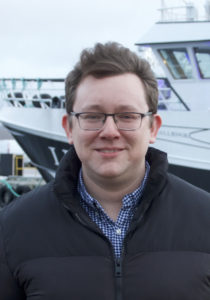Scottish fishermen have warned of a threat to important fishing grounds east of Shetland after Crown Estate Scotland offered seabed agreements for three offshore wind projects in the area last week, reports Tim Oliver.
The announcement from the ScotWind clearing process came as an offshore wind supply chain summit was being held in Aberdeen last Monday (22 August), which included a keynote address by Scotland’s first minister Nicola Sturgeon.

The area of seabed covered by the three projects east of Shetland is just over 560km2.
All three projects are for floating wind farms, which take up more space than conventional fixed turbines. The area of seabed covered by the three projects is just over 560km2. They are expected to generate 2.8GW of electricity.
In her speech, Nicola Sturgeon said offshore wind was one of Scotland’s ‘most important economic and environmental opportunities’, which would bring benefits for all of Scotland, especially in the North East.
But fishing industry representatives warned of the threat to fishing grounds, saying that there had been little consultation on the sites, and that more research was needed on the long-term effects of wind farms on fish and shellfish stocks.
Shetland Fishermen’s Association executive officer Daniel Lawson said the areas in question overlapped with known nursery grounds for haddock and spawning sites for saithe – two of the Shetland fishing fleet’s most valuable whitefish catches.
“The impact of these projects on nursery grounds and spawning sites is unknown, and research is urgently needed before productive and pristine fishing grounds are destroyed in this offshore wind rush,” he said.
“It is clear to everyone that more renewable energy is needed. However, fish is a low-carbon source of nutritious protein food, and displacing legitimate fishing activity is environmental madness.
“These and other wind farm developments will have an impact on ecosystems, and therefore on fish stocks and fisheries in the area. Unlike the offshore wind farm sector, fishing relies entirely on the good state of marine ecosystems for its survival.
“The Scottish government is effectively privatising areas of seabed which are critical to our local economy here in Shetland, for the benefit of Irish, Norwegian and French/Spanish multinationals.”

Daniel Lawson: “The Scottish government is effectively privatising areas of seabed which are critical to our local economy here in Shetland, for the benefit of Irish, Norwegian and French/ Spanish multinationals.”
Daniel Lawson added that it was imperative for the impact of any projects that do proceed to be minimised, especially by the use of joined-up cable corridors to protect inshore fisheries, and mandatory tension leg mooring systems so that turbine anchor lines take up less space.
Mike Park, chief executive of the Scottish White Fish Producers’ Association, said the areas where the wind farms were to be sited were important fishing grounds – as was everywhere east and west of Shetland. He said the rapid expansion of wind farms was becoming ‘extremely concerning’ for the fishing industry, as was the lack of consultation.
He expressed alarm at the overall ‘spatial squeeze’ on fishing grounds from a variety of causes, which he said was making the industry increasingly inefficient.
“There’s been very little consultation on these sites,” he told Fishing News.
“Wind farms are a national priority: they’re moving things on, they’re speeding things up, they are encroaching into fishing areas where they don’t have to.”
He said there had also been no proper research into the effects of wind farms and the electromagnetic fields they create on fish and shellfish.
He said it was ‘galling’ that the industry had had ‘the precautionary principle preached at us’ for more than two decades, but there was no precautionary principle applied in the case of the lack of knowledge about the impact of wind farms.
“We don’t know what long-term harm they’re going to do to the scallop fishery, the crab fishery, the lobster fishery, the whelk fishery – no one has any idea,” he said.
“It’s just a series of area losses, and over time the whole spatial squeeze issue becomes real. We had oil and gas back in the 1970s, and the pipelines. We’ve now got wind farms, we’ve got fish farms west of Scotland, we’ve got seaweed farms inshore, we’ve got MPAs, we’re going to have HPMAs.
“It’s becoming extremely alarming the amount of sea the fishing industry is starting to lose.”
He pointed out that the wind blows everywhere but that there were ‘hotspot’ fishing grounds where fishermen went because they were the most productive, but which they were now losing.
“Fishermen don’t go to some areas because it’s going to take them longer to catch the fish they want – but the more of the productive areas they’re taking away from us, the more inefficient we become.
“It’s almost like planned inefficiency through government approaches.”
This story was taken from the latest issue of Fishing News. For more up-to-date and in-depth reports on the UK and Irish commercial fishing sector, subscribe to Fishing News here or buy the latest single issue for just £3.30 here.






